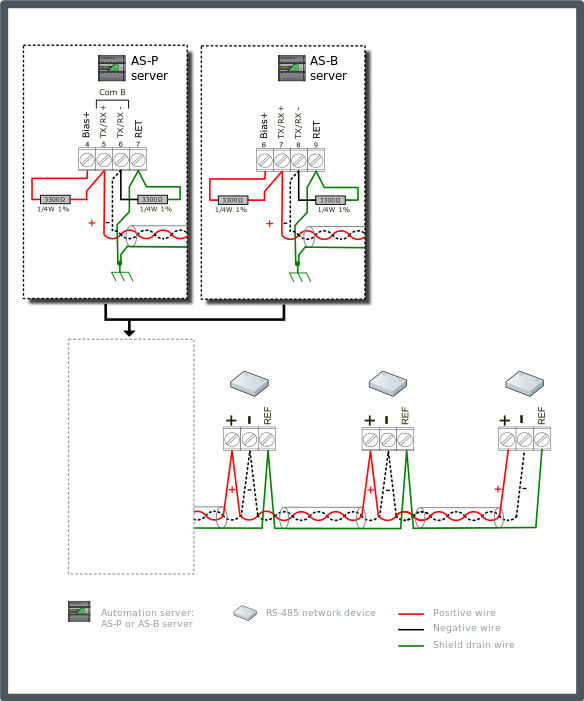
Concept
Generic RS-485 Network Device Configuration 4
This configuration is recommended if the following conditions apply to the RS-485 network and the devices to be connected to the automation server's RS-485 port:
Not all RS-485 network devices have failsafe receivers.
All RS-485 network devices have isolated RS-485 interfaces.
The maximum data rate required is 19,200 bps or lower.
The maximum network cable length required is 150 m (500 ft) or less.
For data rates of 19,200 bps or lower, and network lengths of 150 m (500 ft) or less, it is suggested that termination can be omitted. Omission of termination avoids the requirement to add strong (low resistance) network bias. Such bias imposes reductions on the node capacity and also reduces cable length (if bias is applied from a single end).
Connect a 3300 ohm bias resistor from the TX/RX+ terminal to the Bias+ terminal on the automation server (see the figure below). Connect another 3300 ohm bias resistor from the TX/RX- terminal to the RET terminal on the automation server.
Connect the shield drain wire to earth ground terminal rail in the panel with the automation server This is the only ground connection of the shield for the complete cable segment. Connect the RET terminal on the automation server to the ground rail in the panel using a 12 AWG (3.31 mm²) to 18 AWG (0.82 mm²) wire.
The shield drain wires from the cable segments are connected to the RS-485 reference/common terminal at each RS-485 network device.
The example diagram below shows the alternate RS-485 terminal block connections for the different automation server models.
The example diagram below shows the RS-485 Com B connections on the AS-P and AS-B servers. The guidelines are the same for Com A. When failsafe bias resistors are required on the Com A network, the pull-up voltage is obtained from the Bias+ terminal.

The unit load rating of the network product will determine the recommended maximum number of nodes you should install on this copper segment. The standard unit load budget for an RS-485 segment is 32UL. If all devices on the bus segment are isolated RS-485 interfaces (except the automation server), it is recommended that we can boost the starting budget to 48UL. This extra UL capacity is related to fact that the isolated interfaces provide an avoidance of Common Mode Voltage. Pour plus d'informations, voir Expanded Unit Load with Network of Isolated Devices Only (MNB and Generic RS-485 Devices) .
We must determine the UL node budget available after subtracting the load imposed by the bias resistors and the automation server. The recommended 3300 bias resistors present a unit load of 3.6 (12,000 / 3,300). The automation server adds 0.5UL.
For a bus with all isolated interfaces, the remaining node budget is: 48 - 3.6 - 0.5 = 43.9UL
For the network device load, select the higher unit load value between answers Q5 and Q6b. Pour plus d'informations, voir Worksheet for Configuration of RS-485 Bus with Generic RS-485 Devices . Divide the node budget value by the device UL value (Q5 or Q6b, whichever is greater). The result is the maximum recommended node count in regards to bus loading.
Example: If the answer to Q5 was 0.25 and the answer to Q6b was 0.32, use the value 0.32.
For all isolated interfaces, the maximum node count is: 43.9 / 0.32 = 137 nodes
In this unterminated configuration with a 3300 ohm bias, the extra 3.6UL unit load (when combined with a full 32UL load of network devices) presents only a minimal impact on the reduction of CMV. Pour plus d'informations, voir Unit Load Definition, Maximum Network Load and Affects of Excess Unit Load (MNB and Generic RS-485 Devices) .
The recommended limits on RS-485 bus node counts discussed here pertain to hardware bias and unit load considerations only. The recommended maximum node count may be further limited based on product and system version.
 Generic RS-485 Network Devices
Generic RS-485 Network Devices
 Configuration Selection for Generic RS-485 Network Devices
Configuration Selection for Generic RS-485 Network Devices
 Expanded Unit Load with Network of Isolated Devices Only (MNB and Generic RS-485 Devices)
Expanded Unit Load with Network of Isolated Devices Only (MNB and Generic RS-485 Devices)
 Worksheet for Configuration of RS-485 Bus with Generic RS-485 Devices
Worksheet for Configuration of RS-485 Bus with Generic RS-485 Devices
 Unit Load Definition, Maximum Network Load and Affects of Excess Unit Load (MNB and Generic RS-485 Devices)
Unit Load Definition, Maximum Network Load and Affects of Excess Unit Load (MNB and Generic RS-485 Devices)